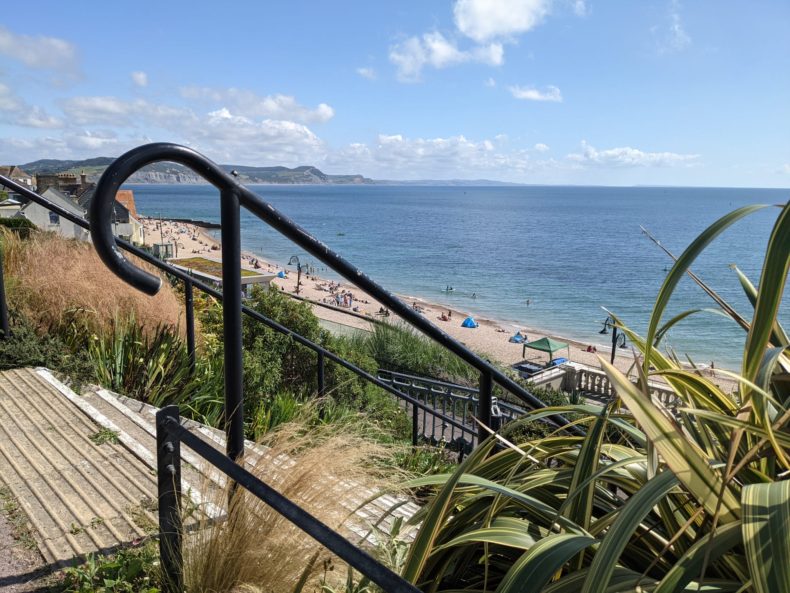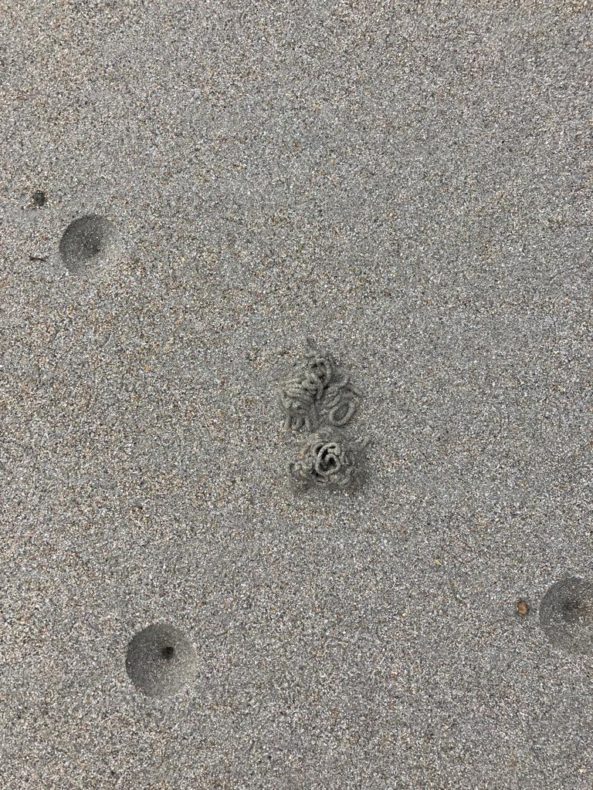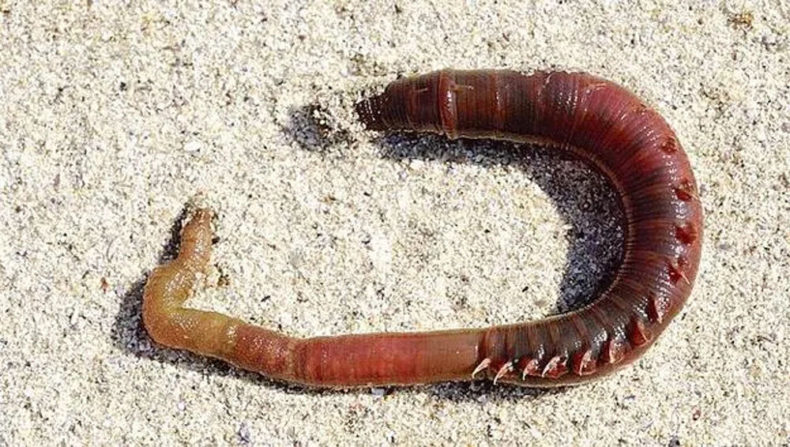
“The English Riviera”. A phrase that sounds like a classic example of British acerbic humour, and I had already emotionally prepared myself to laugh despondently at the sight of some especially bleak industrial waterfront. But when I drove down to the South Coast of England, through hours of the most glorious “sunlit uplands” countryside you ever saw, and the low hills parted to reveal a glimpse of the jewel tone shoreline and palm trees? (Palm trees! in England!) The whole scene has been surprising and delighting Americans since at least 1986 if you go by this article in the Los Angeles Times:
“Exotic plants and palms unexpectedly thrive in this mild southwesterly climate. The palm-lined waterfront walk leads along a green park with fountains, flowers and a pavilion built in the wonderful British Raj architecture of Queen Victoria’s time.”
A closer inspection of the beach, however, revealed some blemishes on this ritzy scene. As we made our way across the wet sand toward the water at low tide, we found the whole expanse pocked with a regular pattern of little wet gasping holes. Each hole was accompanied by a small pyramid of what looked like thin, brown, squiggly sausage. You cannot look at this and think anything but ‘poop’.

Gingerly and with great distaste, I picked my way through this minefield, taking great care to miss them and wincing elaborately when my children exhibited no such self-preserving instincts. Splat splat splat went their little bare feet smashing through the poop pyramids.
Despite the ick factor, however, I had to grudgingly admit that the regular spacing did look cool so I took a picture. Then the friend I was visiting there explained that the little piles were not poops at all but sand sculptures; the stuff that had been displaced to excavate the little holes. Construction rubble, basically.
New question. What was responsible for all this excavation?
I lay down in the sand and peered down into one of the holes, getting my eyeball as close to the edge as I could.
Had I remembered my LWON colleague Jennifer Holland’s 2018 post about the animals that live in those holes, I’m not sure I would have assumed this position.
Less than a foot below my eyeball, writes Jennifer,
“there is a beach-size horizontal worm layer (think sand-worm tiramisu) … that makes up almost a third of the biomass of an average beach in their range, so the tiramisu metaphor isn’t far off.”
The tiramisu is comprised of a thick stack of these guys: they are called lugworms or, more charmingly, “blow lugs”.

Each of these fat wrigglers is between 10 and 20 centimeters long and decorated with external gills that look like spikes but are used for breathing. They live under the holes where they snack on the organic matter left by the receding tide.
In the 1970s biologists noticed something strange about their blood. (And yes they have blood. All segmented worms have blood – most of them even have red blood just like us. I did not know that.)
Lugworm blood contains 40 times more oxygen than human blood, thanks to its giant hemoglobin molecule, which scientists think evolved because they have to sit at the bottom of those holes for 8 hours waiting for the tide to go out.
But what’s most relevant to our interests is the weird way their hemoglobin is suspended freely in their blood – which makes them a universal donor. For you and me, our hemoglobin is bound to our red blood cells, but the catch is that different kinds of red blood cells (which determine our blood type) are festooned with different kinds of defensive proteins called antigens. So if your blood type is A, it means your red blood cells have A antigens. If you’re type B, your red blood cells have B antigens. Mix them together and there’s big, life-threatening trouble. Only blood type O lacks those dangerous antigens, which is why it’s the universal blood type.
Complicating matters further, only a subset of type O blood can be given to just anyone on demand.
But if you have lugworm blood to hand, you don’t have to contend with any of these complications, freeing you to ignore blood types and pernickety subtypes. No blood cells, no problems.
This was all very interesting but largely irrelevant until in the early aughts, when mad cow disease left a hole in the blood supply. Researchers started to wonder if lugworms could fill the hole, so to speak.
In 2006, French scientists caught local lugworms and purified their hemoglobin for a test on some lab mice. Most animal blood substitutes result in an immune response. The lugworm blood had no such side effects. (This has since been replicated in rats and dogs.)
Soon a new company called Hemarina started working to take this success into humans. Within ten years, reported Hakai in a profile of Hemarina, their product seemed to improve outcomes for transplants:
“Hemo2Life underwent a major test from 2016 to 2018: 60 patients received kidney transplants of organs that had been stored in Hemo2Life. The patients recovered faster and had improved renal function than those who received organs in the traditional electrolyte preservation solution.”
And then the pandemic came along and revealed a constellation of new use cases. As you probably know from grimly following the doomscroll over the past two years, covid-19 really does a number on your blood. It causes blood clots and more famously, causes blood oxygen levels to drop dangerously. Researchers at Harvard and Pomipou Hospital have hypothesized that intravenous administration of lugworm blood could quickly reoxygenate blood. They also think its unique properties might even stave off the infamous immune response called cytokine storms.
You can farm a lot of worms, but can you possibly harvest enough of these tiny critters to fill a whole human? One alternative would be to study their hemoglobin and create a synthetic version. Which version of blood subsitute will prevail? Maybe all of them. There’s certainly room. The pandemic has created a major, worldwide shortage in the blood supply. A 2021 market research report for synthetic blood substitutes predicted that the growth market for substitutes – any and all of them – will be enormous, shooting from less than $4 billion last year to well over $15 billion in 2027. (They identified Hemarina as a key player, even though one of the company’s covid trials was suspended by the ANSM [the French version of the FDA] in 2021.)
But yeah, if you ever happen upon those little piles of Riviera worm poo, take note. But you probably shouldn’t try to harvest any yourself. If you follow the link at the end of Jennifer’s post that shows you how to suck the lugworms out of their holes, you’ll quickly understand why.
Post-script: I am immediately informed, 5 minutes after publishing the post, that the squiggles are, in fact, poo. But I protest that this is a technicality. It is sand. It’s sand that has been through the worm, but only because the worm took out the organic matter and bits of algae that were hidden in the sand, so if anything, the worm squiggles are a purer form of sand than it started out with. But fine, if you want to be a pedant about it, it’s poo.
–
Photo credits:
British Riviera picture is actually Lyme Regis, but it all looks the same. Sally Adee
The holes and pyramids: Laura Harrison
Lugworm photo from ‘The Long-Held Secret Of Lugworms’ by Kevin Stam. Photo: Phillipe Giraud